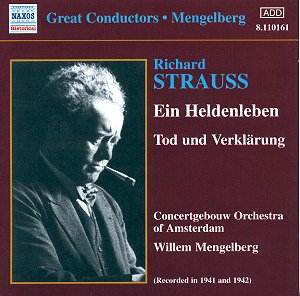Mengelberg and the Concertgebouw Orchestra were pre-eminent
in their day for two main composers, both of whom had worked with these
artists. These were Mahler and Strauss, and the Dutch orchestra and
its Music Director were responsible for making both composers' works
more familiar in northern Europe. This disc, which is very welcome,
concentrates on Strauss, coupling together, as it does, two of the (now)
well known symphonic poems.
Mengelberg’s conducting style has become more well
known over the past ten years or so as a result of a number of companies
releasing Mengelberg’s recordings from the forties and before. This
disc has been remastered by Mark Obert-Thorn, who is one of a few experts
in this field employed by Naxos to help them make the Naxos Historical
Series of recordings. These are all at budget price, and the transfers
generally are of a very high standard.
As with some of the other issues featuring Mengelberg,
this disc was originally issued on 78s by Telefunken. One of the well
known problems with recordings originally made by Telefunken was that
the company used shellac, like many of its competitors, as the base
material for the original records. This material was resistant to wear,
but gave a relatively high level of background noise. The original metal
masters have often been severely damaged by poor storage conditions,
after the war and could not be used. Therefore shellac pressings have
been used, and the minimum of sound processing has been used to reduce
surface noise etc.
Gone are the earlier high levels of surface noise and
distortion, and in their place is relatively clean sound, well balanced
as was the original Telefunken source material. There is a noticeable
but relatively low level of background hiss, now quite uniform, which
is quite acceptable, and does not mar the listening experience.
Willem Mengelberg was Music Director of the Amsterdam
Concertgebouw Orchestra from 1895 – 1945, and during this time ruled
the orchestra with a will of iron. He developed a very free style of
playing, using portamento and variations in tempo which to some listeners
bordered on the perverse. In addition, since he had worked with the
composer, he was not averse to making changes to the score to suit his
interpretation, and using his personal relationship with the composer
as justification for such changes.
Both of these performances are typical Mengelberg interpretations.
Here you find concentration on the grand gestures, the enormous sweep
of the phrasing together with a level of virtuosity from the orchestra
in following their conductor’s every move which is quite astonishing,
even in today’s climate of super efficient orchestral playing. In addition
however, there is a warmth and humanity in the playing which is often
breathtaking.
If you are a fan of Rudolf Kempe or Herbert von Karajan
in Strauss, you will find this issue absolutely fascinating as it presents
another side of Richard Strauss interpretation, which is equally valid
but unique. Well done Naxos – more please.
John Phillips
See also review by Jonathan
Woolf


